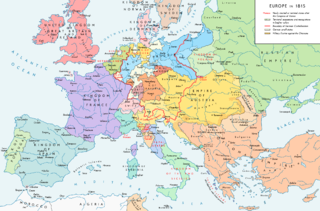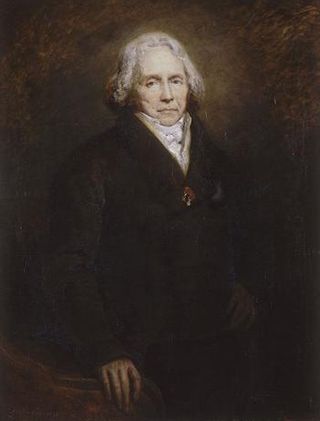
The Congress of Vienna of 1814–1815 was a series of international diplomatic meetings to discuss and agree upon a possible new layout of the European political and constitutional order after the downfall of the French Emperor Napoleon Bonaparte. Participants were representatives of all European powers and other stakeholders, chaired by Austrian statesman Klemens von Metternich, and held in Vienna from September 1814 to June 1815.

The Napoleonic Wars (1803–1815) were a series of conflicts fought between the First French Empire under Napoleon (1804–1815), and a fluctuating array of European coalitions. The wars originated in political forces arising from the French Revolution (1789–1799) and from the French Revolutionary Wars (1792–1802), and produced a period of French domination over Continental Europe. There were seven Napoleonic Wars, five named after the coalitions that fought Napoleon, plus two named for their respective theatres: (i) the War of the Third Coalition (1803–1806), (ii) the War of the Fourth Coalition (1806–1807), (iii) the War of the Fifth Coalition (1809), (iv) the War of the Sixth Coalition (1813–1814), (v) the War of the Seventh Coalition (1815), (vi) the Peninsular War (1807–1814), and (vii) the French invasion of Russia (1812).

Frederick Augustus I was a member of the House of Wettin who reigned as the last Elector of Saxony from 1763 to 1806 and as the first King of Saxony from 1806 to 1827. He was also Duke of Warsaw from 1807 to 1815, and a legitimate candidate to the Polish throne.
The Treaty of Paris, signed on 30 May 1814, ended the war between France and the Sixth Coalition, part of the Napoleonic Wars, following an armistice signed on 23 April between Charles, Count of Artois, and the allies. The treaty set the borders for France under the House of Bourbon and restored territories to other nations. It is sometimes called the First Peace of Paris, as another one followed in 1815.

The Concert of Europe was a general consensus among the great powers of 19th-century Europe to maintain the European balance of power, political boundaries, and spheres of influence. Never a perfect unity and subject to disputes and jockeying for position and influence, the Concert was an extended period of relative peace and stability in Europe following the Wars of the French Revolution and Napoleonic Wars which had consumed the continent since the 1790s. There is considerable scholarly dispute over the exact nature and duration of the Concert. Some scholars argue that it fell apart nearly as soon as it began in the 1820s when the great powers disagreed over the handling of liberal revolts in Italy, while others argue that it lasted until the outbreak of World War I and others for points in between. For those arguing for a longer duration, there is generally agreement that the period after the Revolutions of 1848 and the Crimean War (1853-1856) represented a different phase with different dynamics than the earlier period.

The Austrian Empire, officially known as the Empire of Austria, was a multinational European great power from 1804 to 1867, created by proclamation out of the realms of the Habsburgs. During its existence, it was the third most populous monarchy in Europe after the Russian Empire and the United Kingdom. Along with Prussia, it was one of the two major powers of the German Confederation. Geographically, it was the third-largest empire in Europe after the Russian Empire and the First French Empire.

The Holy Alliance was a coalition linking the monarchist great powers of Austria, Prussia and Russia, which was created after the final defeat of Napoleon at the behest of Emperor (Tsar) Alexander I of Russia and signed in Paris on 26 September 1815. The alliance aimed to restrain liberalism and secularism in Europe in the wake of the devastating French Revolutionary Wars and the Napoleonic Wars; it nominally succeeded in this until the Crimean War. Chancellor Otto von Bismarck managed to reunite the Holy Alliance following the unification of Germany in 1871, but the alliance again faltered by the 1880s over Austrian and Russian conflicts of interest over the dissolution of the Ottoman Empire.

The War of the Second Coalition was the second war on revolutionary France by most of the European monarchies, led by Britain, Austria, and Russia and including the Ottoman Empire, Portugal, Naples and various German monarchies. Prussia did not join the coalition, and Spain supported France.

The Treaties of Tilsit were two agreements signed by French Emperor Napoleon in the town of Tilsit in July 1807 in the aftermath of his victory at Friedland. The first was signed on 7 July, between Napoleon and Russian Emperor Alexander, when they met on a raft in the middle of the Neman River. The second was signed with Prussia on 9 July. The treaties were made at the expense of King Frederick William III of Prussia, who had already agreed to a truce on 25 June after the Grande Armée had captured Berlin and pursued him to the easternmost frontier of his realm. In Tilsit, he ceded about half of his pre-war territories.

The Congress of Aix-la-Chapelle, held in the autumn of 1818, was a high-level diplomatic meeting of France and the four allied powers Britain, Austria, Prussia, and Russia which had defeated it in 1814. The purpose was to decide the withdrawal of the army of occupation from France and renegotiate the reparations it owed. It produced an amicable settlement, whereby France refinanced its reparations debt, and the Allies in a few weeks withdrew all of their troops.

The Fourth Coalition fought against Napoleon's French Empire and were defeated in a war spanning 1806–1807. The main coalition partners were Prussia and Russia with Saxony, Sweden, and Great Britain also contributing. Excluding Prussia, some members of the coalition had previously been fighting France as part of the Third Coalition, and there was no intervening period of general peace. On 9 October 1806, Prussia declared war on France and joined a renewed coalition, fearing the rise in French power after the defeat of Austria and establishment of the French-sponsored Confederation of the Rhine in addition to having learned of French plans to cede Prussian-desired Hannover to Britain in exchange for peace. Prussia and Russia mobilized for a fresh campaign with Prussia massing troops in Saxony.

The Treaty of Fontainebleau was an agreement established in Fontainebleau, France, on 11 April 1814 between Napoleon and representatives of Austria, Russia and Prussia. The treaty was signed in Paris on 11 April by the plenipotentiaries of both sides and ratified by Napoleon on 13 April. With this treaty, the allies ended Napoleon's rule as emperor of the French and sent him into exile on Elba.
The European balance of power is the tenet in international relations that no single power should be allowed to achieve hegemony over a substantial part of Europe. During much of the Modern Age, the balance was achieved by having a small number of ever-changing alliances contending for power, which culminated in the World Wars of the early 20th century. By 1945, European-led global dominance and rivalry had ended and the doctrine of European balance of power was replaced by a worldwide balance of power involving the United States and the Soviet Union as the modern superpowers.

The First French Empire, officially the French Republic, then the French Empire after 1809 and also known as Napoleonic France, was the empire ruled by Napoleon Bonaparte, who established French hegemony over much of continental Europe at the beginning of the 19th century. It lasted from 18 May 1804 to 3 May 1814 and again briefly from 20 March 1815 to 7 July 1815.

Alexander I, nicknamed "the Blessed", was the emperor of Russia from 1801, the first king of Congress Poland from 1815, and the grand duke of Finland from 1809 to his death in 1825. He was the eldest son of Emperor Paul I and Sophie Dorothea of Württemberg.

Diplomatic timeline for 1815
The Treaty of Potsdam was a treaty signed during the War of the Third Coalition on 3 November 1805 between Alexander I of the Russian Empire and Frederick William III of Prussia. It required Prussia to mediate negotiations between Napoleon's French Empire and Russia, and if the negotiations failed, join the Third Coalition.

The Secret Treaty of Vienna was a defensive alliance signed on 3 January 1815 by France, the Austrian Empire and Great Britain. It took place during the Congress of Vienna, negotiations on the future of Europe following Napoleon's defeat in the War of the Sixth Coalition.

The Congress of Châtillon was a peace conference held at Châtillon-sur-Seine, north-eastern France, from 5 February to 5 March 1814, in the latter stages of the War of the Sixth Coalition. Peace had previously been offered by the Coalition allies to Napoleon I's France in the November 1813 Frankfurt proposals. These proposals required that France revert to her "natural borders" of the Rhine, Pyrenees and the Alps. Napoleon was reluctant to lose his territories in Germany and Italy and refused the proposals. By December the French had been pushed back in Germany and Napoleon indicated that he would accept peace on the Frankfurt terms. The Coalition however now sought to reduce France to her 1791 borders, which would not include Belgium.














